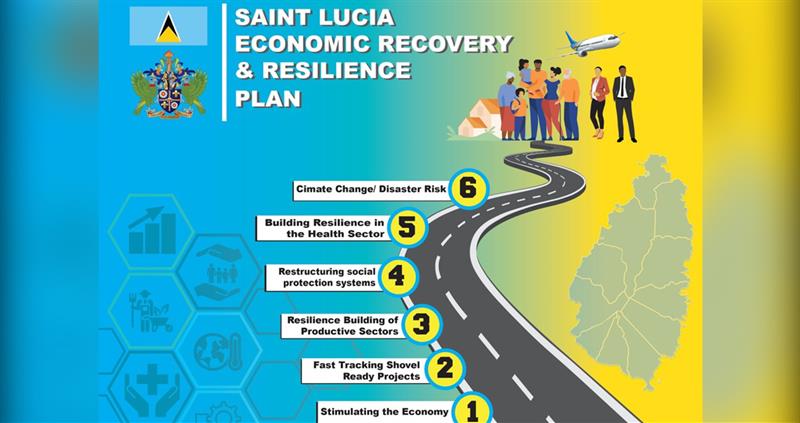OVER 30 AGENCIES FROM BOTH THE PRIVATE AND PUBLIC SECTORS WERE ENGAGED IN THE FORMULATION OF THE PLAN.
 The Government of Saint Lucia is preparing an Economic Recovery and Resilience plan.
The Government of Saint Lucia is preparing an Economic Recovery and Resilience plan.
The plan is designed to stimulate overall economic activity and was borne out of an engaging multi-faceted stakeholder process, encompassing public and private participation including representation from trade unions.
Government employed a three-phased approach to addressing the COVID-19 situation.
The initial component focused on the management of healthcare. This involved an increase in the number of healthcare personnel and personal protective equipment, the establishment of isolation and quarantine centers, and the development of local testing capacity for COVID-19.
The second phase of the plan focused on bringing support to the most vulnerable, and other persons directly impacted by COVID-19 such as those in the tourism, agriculture and transportation sectors.
The acting Permanent Secretary and Director of Finance, Esther Rigobert, said the Economic Recovery and Resilience Plan aims to bring about hope and instill confidence at the household and business levels.
“Many persons were directly impacted. They lost their income, their jobs and there was a sense of fear looming over Saint Lucia. The second phase was to bring immediate support. Some of the measures announced in the Social Stabilization Plan covered areas such as income support, the feeding programme, and ensuring persons who were out of work were able to receive a level of support.
“Under phase three the focus was on recovery and resilience. Recovery in terms of allowing persons who have either lost their jobs, their sources of income, or who need support to restart their businesses; and to get that support either from the government or private sector and financial institutions.”
Over thirty agencies including the Chamber of Commerce, banks and credit unions were engaged for their feedback in the formulation of the Economic Recovery and Resilience Plan.
Chief Economist in the Department of Finance, Janai Leonce, said although the plan takes into account short, medium- and long-term initiatives, emphasis will be placed on the immediate to short term gains over the next six months.
“Some of the issues in the discussions have been: How can we reposition the economy? How can we diversify? We have also had discussions on food security, agro-processing, and lending to the SMEs. Cognizant of these, the plan will include some of those elements. It includes incentives for providing financial support to SME’s and to also repurpose some of our donor funds toward stimulating agro-processing and the adoption of digital technologies.”
Executive Director for the National Competitiveness and Productivity Council, Fiona Hinkson, explained that the planning process was heavily stakeholder-driven and inclusive with line ministries engaging various stakeholders such as the Chamber of Commerce, manufacturers, and other business associations.
“We met to discuss the proposals that we got from the various business associations, and to see how government can put together an appropriate response,” she said, adding that the government also established a multi-sectoral committee comprising over 30 stakeholders from the public and private sectors including representatives from employers and trade unions. Guided by a framework, the committee made recommendations to the government on actions to help the economy recover within the immediate to short term.
“We felt it was necessary not only to look at recovery in the economy but also to building resilience in order to protect us from future events. Regarding economic recovery, we spoke to the fiscal stimulus that would assist in stimulating the economy; and fast-track shovel-ready projects that would help to build economic activity, and provide jobs for persons who are displaced. Regarding resilience, we focused on four resilience pillars that spoke to strengthening the productive sector, strengthening social protection systems, improving health outcomes, and disaster risk mitigation.”
The Permanent Secretary in the Department of Finance said the Economic Recovery and Resilience Plan will touch every facet of the economy.
“There’s a bit for each sector—households, small businesses, and property owners. It is to bring about and instill hope, and confidence that we can come out of this crisis a stronger people, and a stronger nation.”